The Sapphire R9 280X Toxic Review
by Ryan Smith on October 10, 2013 8:00 AM EST- Posted in
- GPUs
- Radeon
- Sapphire
- Tahiti
- Radeon 200
Overclocking
Our final evaluation criteria is overclocking. And this will be short and sweet, as the 280X Toxic isn’t really designed for end user overclocking in the first place. Without voltage adjustment and already shipping at clockspeeds towards the tail end of the curve for the Tahiti GPU, there was absolutely no GPU overclocking headroom for our sample. It was rock solid at stock, but even 10MHz more would eventually result in artifacts when validating the overclock.
Every card will be different of course, and we certainly expect some 280X Toxic cards to have some unexploited headroom, but in the case of our card there was none to be found. Sapphire has fully exploited the available headroom of the GPU in their factory overclock.
| Radeon R9 280X Overclocking | |||||
| Sapphire Radeon R9 280X Toxic | XFX Radeon R9 280X DD | Asus Radeon R9 280X DCU II TOP | |||
| Shipping Core Clock | 1100MHz | 850MHz | 970MHz | ||
| Shipping Boost Clock | 1150MHz | 1000MHz | 1070Mhz | ||
| Shipping Memory Clock | 6.4GHz | 6GHz | 6.4GHz | ||
| Shipping Boost Voltage | 1.256v | 1.2v | 1.2v | ||
| Overclock Core Clock | 1100MHz | 880MHz | 1010MHz | ||
| Overclock Boost Clock | 1150MHz | 1030MHz | 1110MHz | ||
| Overclock Memory Clock | 7GHz | 6.6GHz | 6.8GHz | ||
| Overclock Max Boost Voltage | 1.256v | 1.2v | 1.263v | ||
Now the memory overclock on the other hand was more promising. We were able to get our card up to 7GHz, 600MHz (9%) over the shipping memory frequency and a full 1GHz over what the Hynix modules on the card are technically rated for. Of course the 280X already has so much memory bandwidth that the payoff from additional memory bandwidth isn’t quite as great as say a GTX 770, so coupled with the lack of a core overclock the performance gains are miniscule.
While we’re on the subject, it’s worth pointing out that the 280X Toxic has the highest PowerTune limit of any Tahiti card we’ve tested thus far. Unlike every other card, which tops out at +20% (for 300W or so), the Toxic can go to a full +50%, or somewhere north of 375W. For our testing purposes we stuck with 20% for consistency – the additional headroom wouldn’t be of any value in our games as far as we can tell, as opposed to letting FurMark go nuts – but if it were possible to do voltage adjustments on this card, hardcore overclockers would certainly have a lot of headroom for their water/exotic cooled setups.
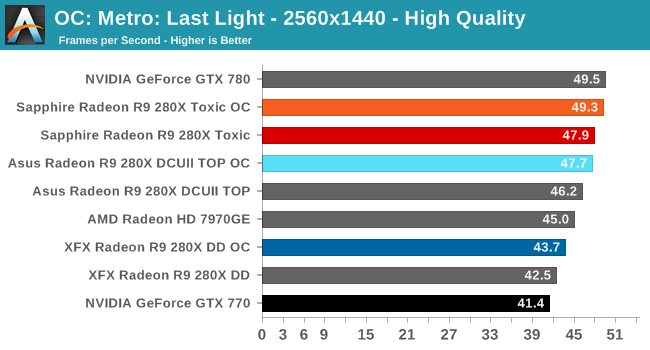
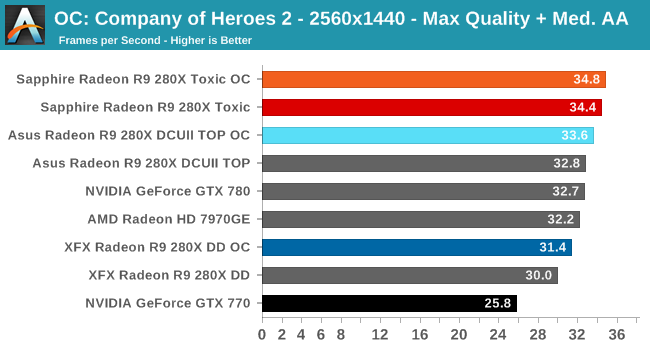
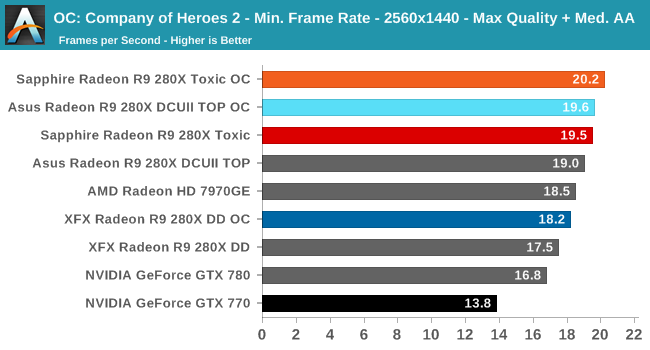
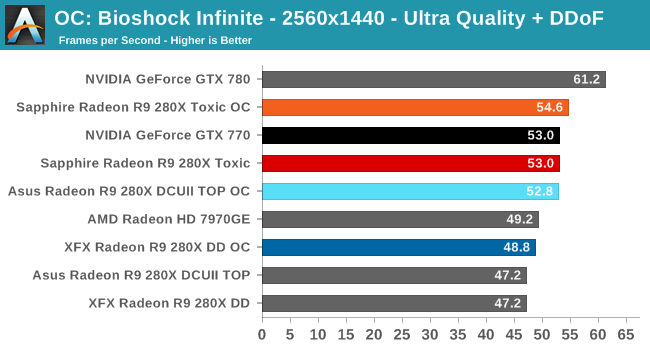
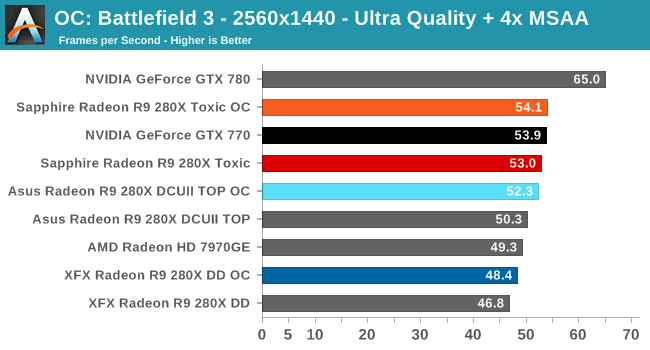

Despite the lack of gains from overclocking, the 280X Toxic is still the fastest 280X card even at stock. Our second best overclocking 280X is the Asus card, which topping out at a boost clock of 1110MHz still falls short of what the Toxic can achieve, and that was after supplying the Asus card with additional voltage. Undoubtedly some 280X cards with voltage adjustment will do better, but our results do paint a very convincing picture for just running the 280X Toxic at stock and ignoring all other cards, with or without overclocking.
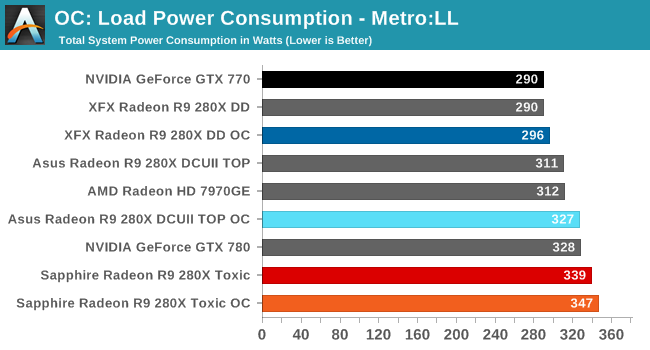
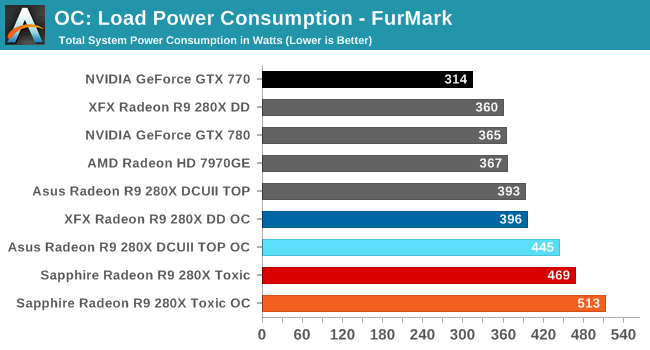
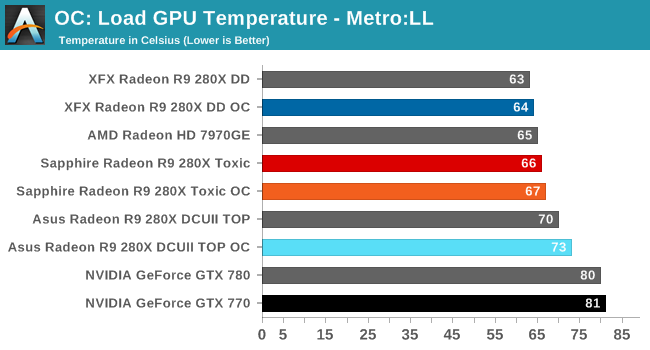

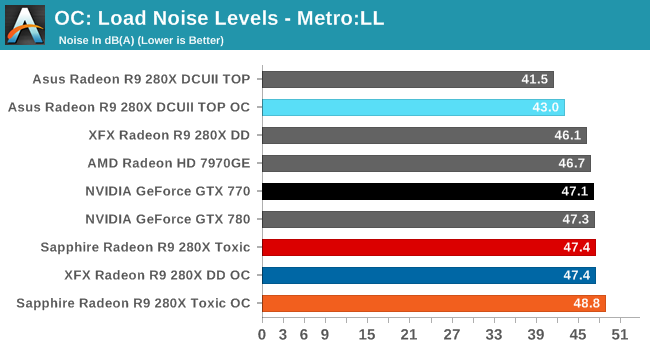
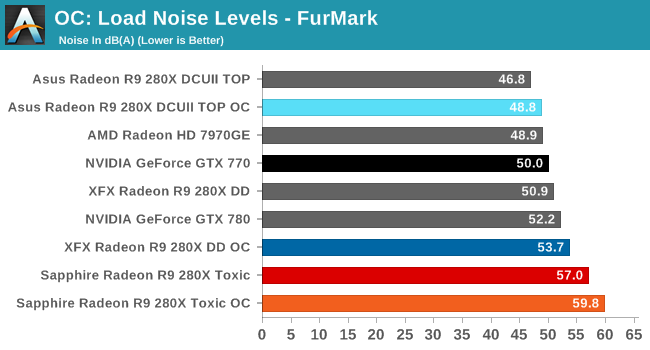
Since we can’t increase the GPU clock or the voltage of the 280X Toxic, the power/temp/noise hit is immaterial under Metro and other gaming workloads. You get almost nothing extra in performance for almost nothing extra in power/temp/noise. With our overclocked results thrown into the mix we can also see that while the stock 280X Toxic outperforms even our overclocked Asus 280X in gaming performance, it also does so while drawing more power than said overclocked Asus card. Clearly nothing is free here; more performance will cause a notable increase in power consumption.
Moving on to FurMark, with that 20% PowerTune increase FurMark absolutely goes nuts. 519W at the wall off of a single card is well out there, and the cooling performance also reflects this. This is all the more reason to leave the 280X Toxic at stock.










84 Comments
View All Comments
EmperorRosko - Friday, October 11, 2013 - link
I really think you need to step back and read your comment. You make no sense whatsoever other than sounding like you are a complete and utter green team excitable mess because a card like this nearly beats a stupidly overpriced card like the 780.The reason they have put a stock GTX780 in the test (which even the vanilla card costs 499 UK POUNDS!!!!) is just to show that a card that costs as low as 260 quid is biting at its heels, of course a customised 780 is going to take another 10% lead but this test is just to show that if you are in the market for a 770/780, this card is something you should seriously considering before dropping cash nVidia's way!
No to mention that when Mantle drops for BF4, this card will more than likely blow a 770/780 out the water anyway and for that game a 290x wont be necessary to hold a massive frame rate.
just4U - Saturday, October 12, 2013 - link
When reviewing cards they usually throw them up against stock variants for comparison.mwildtech - Thursday, October 10, 2013 - link
Sucks this card has no overclock-ability, but at it's price point it makes a stock GTX 780 look like a horrible buy. I know the GTX 780 overclocks like a beast, so It can take a 30% lead pretty easily with an avg OC, but still it's $649 dollars.VaporX - Thursday, October 10, 2013 - link
mwildtech, Overclocking is a hit and miss in every product, especially one that is out of the box clocked at higher values than the competition can often overclock to. That being said two other reviews where able to get some very solid overclocks.MrSpadge - Thursday, October 10, 2013 - link
Agreed - if the card can't even stand 10 MHz more, it will loose stability at stock clocks as soon as the chip degrades a little - which happens exponentially faster with more voltage..just4U - Saturday, October 12, 2013 - link
that's one of my problems with overclocked cards.. I really don't trust them at all and simply prefer a stock card I can screw around with.. give it a great cooler and I am happy..jerrylzy - Saturday, October 12, 2013 - link
I think it can. mine 7970 can stand 1200/1700commissar0617 - Saturday, October 12, 2013 - link
my sapphire 7970/oc has overclock ability. after I change the TIM, i will probably be able to get it to 1.1ghzMombasa69 - Monday, October 14, 2013 - link
It comes with an OC utility....Mombasa69 - Monday, October 14, 2013 - link
Check out bjorn3d(dot)comMentions the OC Utility.